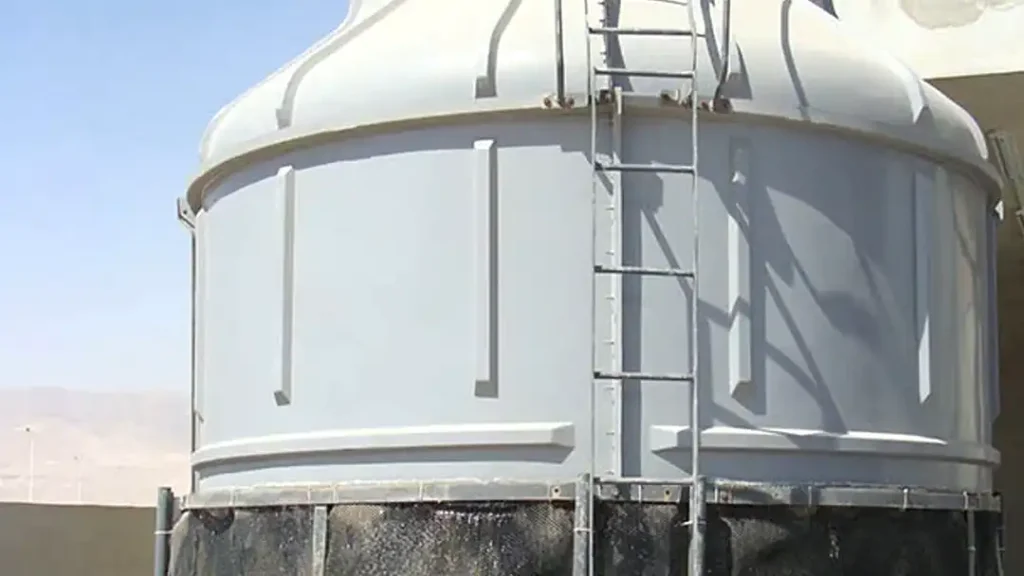Have you ever driven by a large building with a plume of white mist rising from the top? That’s likely a cooling tower, a giant heat exchanger that plays a crucial role in many industrial processes and air conditioning systems.
In this blog, we’ll dive into the world of cooling towers, exploring what they are, how they work, and where you might find them.
What is a Cooling Tower

A cooling tower is a device that removes heat from water by using evaporation. They are typically large structures with hyperbolic shapes, and are used in power plants, air conditioning systems, and industrial processes.
What Does a Cooling Tower Do
A cooling tower acts like a giant radiator for water. Its main function is to remove heat that has been absorbed by water in various industrial processes or buildings. Here’s how it achieves this:
- Warm Water In: Water that’s been heated up during a process (like in a power plant or air conditioning system) gets pumped into the cooling tower.
- Evaporation for Cooling: Inside the tower, the warm water is spread out to maximize its surface area. Fans blow air through the tower, and some of this water evaporates. As water evaporates, it absorbs heat from the remaining water, causing it to cool down.
- Cool Water Out: This cooled water is then pumped back to where it came from, ready to absorb more heat in the process.
In short, cooling towers help regulate temperatures in essential systems by dissipating heat absorbed by water into the atmosphere through evaporation.
Cooling towers work by circulating water through the tower and exposing it to air. As the water evaporates, it cools the remaining water. The cooled water is then returned to the system to be used again.
Types of Cooling Tower
There are two main types of cooling towers:
- Wet cooling towers: These towers use evaporation to cool the water.
- Dry cooling towers: These towers use fans to circulate air over coils of water. The air removes heat from the water, which is then returned to the system.
Wet cooling towers are more common than dry cooling towers, but they can also consume more water. Dry cooling towers are less efficient than wet cooling towers, but they can be a good option in areas where water is scarce.
What is a Cooling Tower Used For
Cooling towers are used in a variety of applications where there’s a need to remove excess heat from water. Here are some of the most common uses:
- Power Plants: Thermal power plants, including nuclear, coal, and natural gas facilities, use cooling towers to remove heat from the water used in the electricity generation process. This hot water wouldn’t be effective in cooling down the machinery for reuse if left unaddressed.
- Air Conditioning Systems: Large commercial and industrial buildings often rely on chiller systems for air conditioning. Cooling towers play a crucial role here by cooling down the water used in the chiller to remove heat from the building.
- Industrial Processes: Many industrial processes generate significant heat. Refineries, chemical plants, and manufacturing facilities all utilize cooling towers to cool water used in various processes, ensuring optimal functioning of equipment and avoiding overheating.
Cooling towers are essential components in maintaining efficient operation across various industries by managing heat generated in water systems.
What is the Function of Cooling Tower
The primary function of a cooling tower is to reject waste heat to the atmosphere. It achieves this by cooling down a stream of circulating water, typically used in industrial processes or building systems.
Here’s a breakdown of how it works:
Warm Water In: Warm water that has absorbed heat from an industrial process or building system (like an air conditioning chiller) enters the cooling tower.
Heat Transfer: Inside the tower, this warm water comes into contact with cooler air, either through evaporation (wet cooling towers) or direct heat exchange (dry cooling towers).
- Wet Cooling Towers: A small portion of the water evaporates, absorbing heat in the process and cooling the remaining water. This is similar to how sweat cools our bodies.
- Dry Cooling Towers: Fans circulate air through a heat exchanger containing the warm water. The cooler air removes heat from the water by conduction.
Cool Water Out: The cooled water then exits the tower and is returned to the original system, ready to absorb more heat.
By removing heat from the water, cooling towers allow these systems to function efficiently. Without them, the water would become too hot and unable to perform its cooling duty.
Conclusion
In conclusion, a cooling tower is a specialized heat exchanger that removes waste heat from water used in various industrial processes and building systems. They act like giant radiators, utilizing air and sometimes evaporation to cool down the water. This cooled water is then recirculated back into the system, allowing it to continue absorbing heat effectively.
Cooling towers play a vital role in ensuring the efficient operation of power plants, air conditioning systems, and numerous industrial processes by managing heat generation and maintaining optimal temperatures.
They come in two main types: wet cooling towers that rely on evaporation for cooling, and dry cooling towers that use fans and heat exchange. While wet cooling towers are more common, dry towers offer a water-saving alternative in areas with water scarcity.

